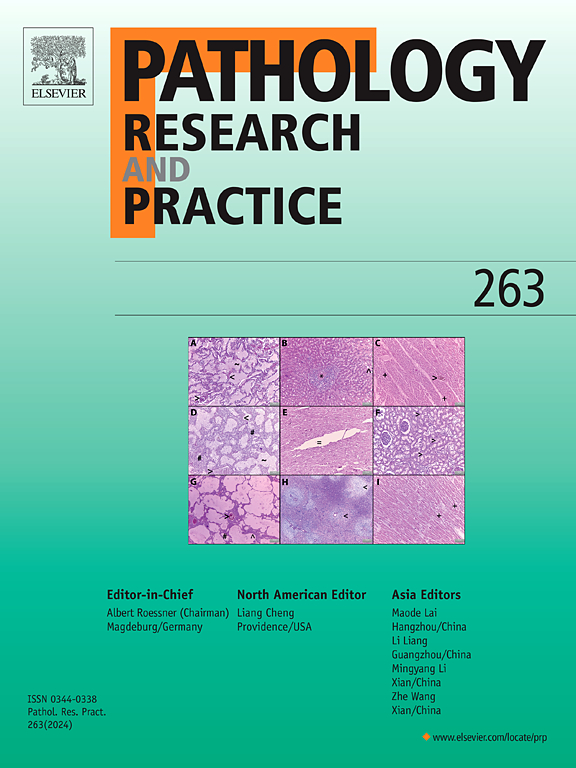A novel variation in the LMX1B gene with nail-patella syndrome
IF 2.9
4区 医学
Q2 PATHOLOGY
引用次数: 0
Abstract
Nail-patella syndrome (NPS; OMIM #161200) is an autosomal dominant disorder characterized by developmental defects in dorsal limb structures, kidneys, and eyes. The incidence of NPS is attributed to variations in the LMX1B gene. In this report, we present a novel LMX1B variation identified in a Chinese family affected by NPS. The proband, a 15-year-old male, exhibited a history of proteinuria and microscopic hematuria accompanied by renal dysfunction, nail dysplasia, bilateral patellar dysplasia, bilateral shoulder and elbow joint dysplasia and iliac horns. Histological examination revealed mild glomerular lesions. Under electron microscopy, irregular thickening of the glomerular basement membrane was observed, characterized by an appearance resembling occasional electron lucent areas ("moth-eaten" appearance) and the presence of disorganized collagen fiber bundles. Pathological findings were consistent with NPS. Genetic analysis identified a novel heterozygous variant, c.791 A>C, p.(Gln264Pro), in the patient, his father and younger brother. This new variant has been annotated as potentially pathogenic according to the recommendation of the American Society for Medical Genetics and Genomics. This represents the first report of a novel variation in the LMX1B gene. These findings expand the spectrum of variations associated with LMX1B in NPS.
指甲-髌骨综合征中LMX1B基因的新变异
趾甲-髌骨综合征;OMIM #161200)是一种常染色体显性遗传病,以背肢结构、肾脏和眼睛发育缺陷为特征。NPS的发病率归因于LMX1B基因的变异。在这篇报告中,我们提出了一个新的LMX1B变异,在一个受NPS影响的中国家庭中发现。先证者为15岁男性,有蛋白尿和镜下血尿病史,并伴有肾功能不全、指甲发育不良、双侧髌骨发育不良、双侧肩关节和肘关节发育不良及髂角。组织学检查显示轻度肾小球病变。电镜下可见肾小球基底膜不规则增厚,表现为偶有电子透光区(“虫蛀”样),胶原纤维束排列紊乱。病理表现与NPS一致。遗传分析在患者及其父亲和弟弟中发现了一种新的杂合变异,C .791 A>;C, p.(Gln264Pro)。根据美国医学遗传学和基因组学学会的建议,这种新的变异已被注释为具有潜在致病性。这是关于LMX1B基因新变异的首次报道。这些发现扩大了NPS中与LMX1B相关的变异谱。
本文章由计算机程序翻译,如有差异,请以英文原文为准。
求助全文
约1分钟内获得全文
求助全文
来源期刊
CiteScore
5.00
自引率
3.60%
发文量
405
审稿时长
24 days
期刊介绍:
Pathology, Research and Practice provides accessible coverage of the most recent developments across the entire field of pathology: Reviews focus on recent progress in pathology, while Comments look at interesting current problems and at hypotheses for future developments in pathology. Original Papers present novel findings on all aspects of general, anatomic and molecular pathology. Rapid Communications inform readers on preliminary findings that may be relevant for further studies and need to be communicated quickly. Teaching Cases look at new aspects or special diagnostic problems of diseases and at case reports relevant for the pathologist''s practice.

 求助内容:
求助内容: 应助结果提醒方式:
应助结果提醒方式:


